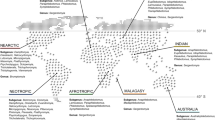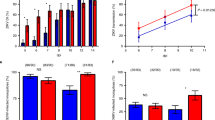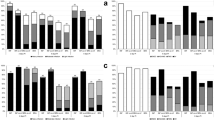Abstract
Sand flies, similar to most vectors, take multiple blood meals during their lifetime1,2,3,4. The effect of subsequent blood meals on pathogens developing in the vector and their impact on disease transmission have never been examined. Here, we show that ingestion of a second uninfected blood meal by Leishmania-infected sand flies triggers dedifferentiation of metacyclic promastigotes, considered a terminally differentiated stage inside the vector5, to a leptomonad-like stage, the retroleptomonad promastigote. Reverse metacyclogenesis occurs after every subsequent blood meal where retroleptomonad promastigotes rapidly multiply and differentiate to metacyclic promastigotes enhancing sand fly infectiousness. Importantly, a subsequent blood meal amplifies the few Leishmania parasites acquired by feeding on infected hosts by 125-fold, and increases lesion frequency by fourfold, in twice-fed compared with single-fed flies. These findings place readily available blood sources as a critical element in transmission and propagation of vector-borne pathogens.
This is a preview of subscription content, access via your institution
Access options
Access Nature and 54 other Nature Portfolio journals
Get Nature+, our best-value online-access subscription
$29.99 / 30 days
cancel any time
Subscribe to this journal
Receive 12 digital issues and online access to articles
$119.00 per year
only $9.92 per issue
Buy this article
- Purchase on Springer Link
- Instant access to full article PDF
Prices may be subject to local taxes which are calculated during checkout




Similar content being viewed by others
References
Guzman, H., Walters, L. L. & Tesh, R. B. Histologic detection of multiple blood meals in Phlebotomus duboscqi (Diptera: Psychodidae). J. Med. Entomol. 31, 890–897 (1994).
Norris, L. C., Fornadel, C. M., Hung, W. C., Pineda, F. J. & Norris, D. E. Frequency of multiple blood meals taken in a single gonotrophic cycle by Anopheles arabiensis mosquitoes in Macha, Zambia. Am. Trop. Med. Hyg. 83, 33–37 (2010).
Kramer, L. D. & Ebel, G. D. Dynamics of flavivirus infection in mosquitoes. Adv. Virus Res. 60, 187–232 (2003).
Abbasi, I., Cunio, R. & Warburg, A. Identification of blood meals imbibed by phlebotomine sand flies using cytochrome b PCR and reverse line blotting. Vector Borne Zoonotic Dis. 9, 79–86 (2009).
Bates, P. A. Transmission of Leishmania metacyclic promastigotes by phlebotomine sand flies. Int. J. Parasitol. 37, 1097–1106 (2007).
Vector-Borne Diseases (WHO, 2014); http://apps.who.int/iris/handle/10665/206531?mode=full
Das, S., Muleba, M., Stevenson, J. C., Pringle, J. C. & Norris, D. E. Beyond the entomological inoculation rate: characterizing multiple blood feeding behavior and Plasmodium falciparum multiplicity of infection in Anopheles mosquitoes in northern Zambia. Parasit. Vectors 10, 45 (2017).
Dostalova, A. & Volf, P. Leishmania development in sand flies: parasite-vector interactions overview. Parasit. Vectors 5, 276 (2012).
Aslan, H. et al. A new model of progressive visceral leishmaniasis in hamsters by natural transmission via bites of vector sand flies. J. Infect. Dis. 207, 1328–1338 (2013).
Collin, N. et al. Sand fly salivary proteins induce strong cellular immunity in a natural reservoir of visceral leishmaniasis with adverse consequences for Leishmania. PLoS Pathog. 5, e1000441 (2009).
Howard, M. K., Sayers, G. & Miles, M. A. Leishmania donovani metacyclic promastigotes: transformation in vitro, lectin agglutination, complement resistance, and infectivity. Exp. Parasitol. 64, 147–156 (1987).
Serafim, T. D. et al. Leishmania metacyclogenesis is promoted in the absence of purines. PLoS Negl. Trop. Dis. 6, e1833 (2012).
Ready, P. D. Biology of phlebotomine sand flies as vectors of disease agents. Annu. Rev. Entomol. 58, 227–250 (2013).
Kamhawi, S. Phlebotomine sand flies and Leishmania parasites: friends or foes? Trends Parasitol. 22, 439–445 (2006).
Alexander, B., de Carvalho, R. L., McCallum, H. & Pereira, M. H. Role of the domestic chicken (Gallus gallus) in the epidemiology of urban visceral leishmaniasis in Brazil. Emerg. Infect. Dis. 8, 1480–1485 (2002).
Sant’anna, M. R. et al. Chicken blood provides a suitable meal for the sand fly Lutzomyia longipalpis and does not inhibit Leishmania development in the gut. Parasit. Vectors 3, 3 (2010).
Guimaraes, E. S. A. S. et al Leishmania infection and blood food sources of phlebotomines in an area of Brazil endemic for visceral and tegumentary leishmaniasis. PLoS ONE 12, e0179052 (2017).
Rogers, M. E. The role of Leishmania proteophosphoglycans in sand fly transmission and infection of the mammalian host. Front Microbiol. 3, 223 (2012).
Kimblin, N. et al. Quantification of the infectious dose of Leishmania major transmitted to the skin by single sand flies. Proc. Natl Acad. Sci. USA 105, 10125–10130 (2008).
Bates, P. A. Leishmania sand fly interaction: progress and challenges. Curr. Opin. Microbiol. 11, 340–344 (2008).
Gossage, S. M., Rogers, M. E. & Bates, P. A. Two separate growth phases during the development of Leishmania in sand flies: implications for understanding the life cycle. Int. J. Parasitol. 33, 1027–1034 (2003).
Killick-Kendrick, R. & Rioux, J. A. Mark-release-recapture of sand flies fed on leishmanial dogs: the natural life-cycle of Leishmania infantum in Phlebotomus ariasi. Parassitologia 44, 67–71 (2002).
Lawyer, P., Killick-Kendrick, M., Rowland, T., Rowton, E. & Volf, P. Laboratory colonization and mass rearing of phlebotomine sand flies (Diptera, Psychodidae). Parasite 24, 42 (2017).
Oliveira, F. et al. A sand fly salivary protein vaccine shows efficacy against vector-transmitted cutaneous leishmaniasis in nonhuman primates. Sci. Transl. Med. 7, 290ra290 (2015).
Sacks, D. L. & Melby, P. C. Animal models for the analysis of immune responses to leishmaniasis. Curr. Protoc. Immunol. 108, 11–24 (2015).
Sacks, D. L. & Perkins, P. V. Identification of an infective stage of Leishmania promastigotes. Science 223, 1417–1419 (1984).
Gomes, R. et al. Immunity to a salivary protein of a sand fly vector protects against the fatal outcome of visceral leishmaniasis in a hamster model. Proc. Natl Acad. Sci. USA 105, 7845–7850 (2008).
Selvapandiyan, A. et al. Intracellular replication-deficient Leishmania donovani induces long lasting protective immunity against visceral leishmaniasis. J. Immunol. 183, 1813–1820 (2009).
Kamhawi, S., Belkaid, Y., Modi, G., Rowton, E. & Sacks, D. Protection against cutaneous leishmaniasis resulting from bites of uninfected sand flies. Science 290, 1351–1354 (2000).
Schneider, C. A., Rasband, W. S. & Eliceiri, K. W. NIH Image to ImageJ: 25 years of image analysis. Nat. Methods 9, 671–675 (2012).
Acknowledgements
We would like to thank E. Fischer and S. Ricklefs from the Research Technology Branch (RTB), NIAID, for electron microscopy support; R. Kissinger from RTB, NIAID, for illustration support; A. Perkins and W. de Castro from VMBS, NIAID, for technical support; V. Vernyuy, T.R. Wilson and B.G. Bonilla from LMVR, NIAID for sand fly insectary support; R. Dey and H. Nakhasi from CBER, FDA, for help with qPCR; A.M.A. Souza for help with statistical analysis and C. Barillas-Mury and J.M.C. Ribeiro from LMVR, NIAID, for critical reading of the manuscript. This research was supported by the Intramural Research Program of the NIH, National Institute of Allergy and Infectious Diseases.
Author information
Authors and Affiliations
Contributions
T.D.S. and I.V.C.A. designed and performed the experiments. T.D.S. analysed the data. I.V.C.A analysed qPCR data. C.M. performed sand fly insectary work. J.G.V., S.K. and F.O. were involved in the design, interpretation and supervision of this study. All authors wrote the manuscript.
Corresponding authors
Ethics declarations
Competing interests
The authors declare no competing interests
Additional information
Publisher’s note: Springer Nature remains neutral with regard to jurisdictional claims in published maps and institutional affiliations.
Supplementary information
Supplementary Information
Supplementary Figures 1–4. Supplementary Tables 1–3. Legends for Supplementary Videos 1–8.
Videos
Supplementary Video 1
Fast-swimming metacyclics at mature infection.
Supplementary Video 2
Fast-swimming metacyclics at mature infection.
Supplementary Video 3
Fast-swimming metacyclics dedifferentiate into slow moving retroleptomonads after a subsequent uninfected blood meal.
Supplementary Video 4
Fast-swimming metacyclics dedifferentiate into slow moving retroleptomonads after a subsequent uninfected blood meal.
Supplementary Video 5
Dedifferentiation of a metacyclic promastigote – representative event 1.
Supplementary Video 6
Dedifferentiation of a metacyclic promastigote – representativeevent 2.
Supplementary Video 7
Dedifferentiation of a metacyclic promastigote – representativeevent 3.
Supplementary Video 8
The haptomonad parasite sphere of an infected sand fly after a subsequent uninfected blood meal.
Rights and permissions
About this article
Cite this article
Serafim, T.D., Coutinho-Abreu, I.V., Oliveira, F. et al. Sequential blood meals promote Leishmania replication and reverse metacyclogenesis augmenting vector infectivity. Nat Microbiol 3, 548–555 (2018). https://doi.org/10.1038/s41564-018-0125-7
Received:
Accepted:
Published:
Issue Date:
DOI: https://doi.org/10.1038/s41564-018-0125-7
This article is cited by
-
Age, sex, and mating status discrimination in the sand fly Lutzomyia longipalpis using near infra-red spectroscopy (NIRS)
Parasites & Vectors (2024)
-
Disentangling detrimental sand fly-mite interactions in a closed laboratory sand fly colony: implications for vector-borne disease studies and guidelines for overcoming severe mite infestations
Parasites & Vectors (2024)
-
TORC1 is an essential regulator of nutrient-controlled proliferation and differentiation in Leishmania
EMBO Reports (2024)
-
Leishmania genetic exchange is mediated by IgM natural antibodies
Nature (2023)
-
An overview of the trypanosomatid (Kinetoplastida: Trypanosomatidae) parasites infecting several mammal species in Colombia
Parasites & Vectors (2022)



